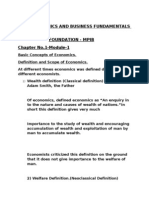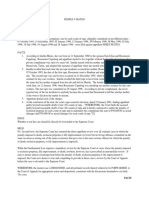Chapter 1 Introduction Eco 11
Uploaded by
ArhamChapter 1 Introduction Eco 11
Uploaded by
ArhamChapter 1 Introduction
Q1. Define Economics.
Ans: Economics is the science that studies human behaviour which aims at allocation of
scarce resources in such a way that consumer can maximise their satisfaction, producers can
maximise their profits and society can maximise its social welfare. It is about making choice
in the presence of scarcity.
Q2. Who is known as the father of Economics?
Ans: Adam Smith
Q3. Define Scarcity.
Ans: Scarcity means shortage of goods and resources in relation to their demand.
Q4. Define Statistics.
Ans: 1. Statistics: Statistics can be defined in two senses-
(a) In plural sense: Statistics means Numerical facts and figures which have been
systematically collected for a definite purpose in any field of study. For example
statistics of births, statistics of plants, statistics of students, statistics of imports and
exports etc.
(b) In singular sense: Statistics is the subject that deals with the collection, organisation,
presentation, analysis and interpretation of data.
Q5. What are the stages in statistical investigation?
Ans: The common stages or steps in any statistical investigation are:
(1) Collection of data: The process of collecting and arranging important information
from a particular sample or population is known as collection of data. There are two
methods of data collection- Primary data and Secondary data.
(2) Organization of data: It means summarization of data in some meaningful way, e.g.
tabular form.
(3) Presentation of the data: The process of re-organization, classification, compilation,
and summarization of data to present it in a meaningful form.
(4) Analysis of data: The process of extracting relevant information from the summarized
data, mainly through the use of elementary mathematical operation.
Q6. What is statistical data?
Ans: Statistical data are of two types-
(1) Qualitative data – Qualitative data are those which are not measured in numerical
terms like beauty and intelligence.
(2) Quantitative data – These data are measured in numerical terms like price and income.
Q7. State the importance of Statistics.
Ans: Importance of statistics in economics are –
1) It enables an economist to present economics facts in precise and definite form.
2) Statistics is used in finding relationship between different economic factors.
3) Helpful to formulate appropriate economic policies that solve economic problems.
4) It is a quantitative expression for economic problem.
Q8. What are the function of statistics?
Ans: The functions of statistics are –
1) Statistics simplifies complexities.
2) It expresses facts in numbers.
3) It presents data in condensed form.
4) Statistics is helpful in economic forecasting.
Q9. What are the limitations of statistics?
Ans: 1. Statistics does not study individuals.
2. Statistics deals with quantitative facts only.
3. Statistics laws are true only on averages.
4. Study of aggregates only.
Q10. Define the following.
1. Producer – Producer is one who produces goods and services for the generation of
income.
2. Consumer – A consumer or a customer is characterised as an individual who purchases
goods and services to satisfy his wants.
3. Employee – An employee is a person who gets compensation in the form of salary or
wages for their services rendered to the employer.
4. Employer – An employer is a person or an organisation that employs one or more people
to produce goods or services by providing them with compensation in the form of salary or
wages in return for work done by them.
5. Economic Activity – Economic activities are those activities which are related to earn
money and wealth for life. These activities generate new income and increase the flow of
goods and services. For example production, consumption, investment, distribution.
6. Seller – The term seller alludes to a party that offers a service, an asset, or a product as a
trade-off for payment. A seller can be an individual, enterprise, government, or any other
entity.
7. Economic Data – Economic data measures the well-being and financial health of
individual markets, specific markets, specific regions, or a country. The data presented can
usually be of the present compared with the past data. Economic data is used to influence
monetary examination and advance other categories of monetary information or data.
8. Service holder – A person who is in job and gives his services as a factor of production
and is getting paid for it. E.g. Govt. Teacher.
9. Service provider – A person who provides services to other for a payment. E.g.
Transporter, Auto driver
You might also like
- NRF - R134a-R1234yf Airconditioning Filling Chart67% (3)NRF - R134a-R1234yf Airconditioning Filling Chart1 page
- Revision Notes for Cbse Class 11 Economics Chapter 1No ratings yetRevision Notes for Cbse Class 11 Economics Chapter 12 pages
- Introduction_to_statistics-Study_MaterialNo ratings yetIntroduction_to_statistics-Study_Material8 pages
- Provider. For Example, A Doctor Renders His/her Medical Services in Exchange of The FeesNo ratings yetProvider. For Example, A Doctor Renders His/her Medical Services in Exchange of The Fees3 pages
- Chapter 1 Concept of Economics and Significance of Statistics in EconomicsNo ratings yetChapter 1 Concept of Economics and Significance of Statistics in Economics6 pages
- Class 11 Statistics Chapter 1 IntroductionNo ratings yetClass 11 Statistics Chapter 1 Introduction2 pages
- Grade 11 - Introduction to Statistics (notes) schoolNo ratings yetGrade 11 - Introduction to Statistics (notes) school3 pages
- 2024-2025-Class XI-Economics-Chapter 1-AWNo ratings yet2024-2025-Class XI-Economics-Chapter 1-AW30 pages
- XI Chapter 1 Introduction To Statistics With ExerciseNo ratings yetXI Chapter 1 Introduction To Statistics With Exercise4 pages
- Concept of Economiccs: Statistics in EconomicsNo ratings yetConcept of Economiccs: Statistics in Economics15 pages
- Class: Xi Unit I Chapter 1: INTRODUCTION Important ConceptsNo ratings yetClass: Xi Unit I Chapter 1: INTRODUCTION Important Concepts2 pages
- Economics & Business Management (EBM) - Note. Free Download-Pdf - Manu K M100% (5)Economics & Business Management (EBM) - Note. Free Download-Pdf - Manu K M46 pages
- Statistics For Economics Class: Xi Unit I Chapter 1: INTRODUCTION Important ConceptsNo ratings yetStatistics For Economics Class: Xi Unit I Chapter 1: INTRODUCTION Important Concepts2 pages
- ST Container Storage For Dummies Ebook v2 f7543 201705 enNo ratings yetST Container Storage For Dummies Ebook v2 f7543 201705 en27 pages
- For HDFC ERGO General Insurance Company LTDNo ratings yetFor HDFC ERGO General Insurance Company LTD2 pages
- KAS - 2020 Prelims - Gs - 1 (Foresightkas)No ratings yetKAS - 2020 Prelims - Gs - 1 (Foresightkas)20 pages
- ICPEP 2018 National Convention Invites FINAL v4No ratings yetICPEP 2018 National Convention Invites FINAL v41 page
- Performance-Related and Skill-Based Pay: An Introduction: ACT/EMP/17No ratings yetPerformance-Related and Skill-Based Pay: An Introduction: ACT/EMP/1744 pages
- MF-218 Piping and Miscellaneous Practice in Engine Room PDFNo ratings yetMF-218 Piping and Miscellaneous Practice in Engine Room PDF35 pages
- Detection Systems For Reducing The Risk of Hydrogen Fires - Chemical Engineering - Page 3No ratings yetDetection Systems For Reducing The Risk of Hydrogen Fires - Chemical Engineering - Page 34 pages
- Indian Facilities Management Services Report-Final50% (2)Indian Facilities Management Services Report-Final51 pages
- How Politicians Like Kamala Harris Have Long Backed Portland-Style Policing - MarketWatchNo ratings yetHow Politicians Like Kamala Harris Have Long Backed Portland-Style Policing - MarketWatch3 pages
- Wind Loading On A Hyperbolic Paraboloid Free Roof: Journal of Civil Engineering and Architecture October 2014No ratings yetWind Loading On A Hyperbolic Paraboloid Free Roof: Journal of Civil Engineering and Architecture October 201411 pages
- Automatic SQL Injection Tool - Sqlmap - Linux BlogNo ratings yetAutomatic SQL Injection Tool - Sqlmap - Linux Blog3 pages
- Technical Information: Thread Identification GuideNo ratings yetTechnical Information: Thread Identification Guide1 page

























































































